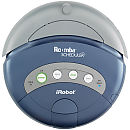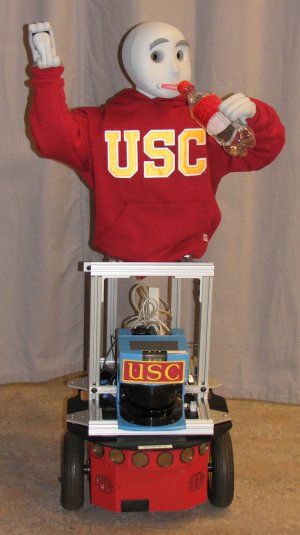
ENGR 150 Engineering Science and Systems:
From Humans to Robots

|
ENGR 150 Engineering Science and Systems:
|
Hands-on multidipsciplinary engineering course that uses robotics as a theme to cover material from computer science, electrical engineering, mecjanical engineering, biomedical engineering, and industrial and systems engineering. Lab course with team projects and an end-of-semester exhibition. Pre-requisites: ability to program. Course flyer
Robots used in the course:


Note: Session corresponds to one lecture day, i.e., 1.5 hours of class time, to be spent in lecture and hands-on in-class work. Lab corresponds to one lab day, also 1.5 hours in duration. Each week is expected to consist of 2 sessions in class (Mondays and Wednesdays, 10:30-noon) and 1 in lab (Fridays, 10:30-noon), a total of 4.5 hours.
Tuesday, Aug 26, Session 1: Introduction
Introduction to the course scope, team assignments, handouts:
Prof. Mataric´
Thursday, Aug 28, Session 2: What makes a robot?
Defining a robot, its key components, and challenges of robotics as
they relate to engineering topics. Textbook chapters 1 and 3.
Prof. Mataric´
Lab 1: Introduction to the hadware and software
platforms.
Tuesday, Sep 2, Session 3: Design methodologies and team
management
Design methodologies: How to come up with ideas (for robot strategies,
for example), ways of prototyping the ideas to figure out what might
work best, how to go about selecting ideas, and implementing/testing
them. Team management: How to plan out work for the semester, and how
to work on a team: Prof. Dana Sherman
Thursday, Sep 4, Session 4: Sensing and simple senors
What
is sensory perception, biological v. machine perception, the
electronics and mechanics of simple sensors. Computational strategies
for filtering sensory data to deal with noise. Textbook chapters 7 and
8. Prof. Mataric´
Lab 2: see lab syllabus
Tuesday, Sep 9, Session 6: From data/signals to
state/symbols/objects
Sensory data processing, filtering, and
estimating state, objects and other features of the world. Textbook
chapter 9. Prof. Gaurav Sukhatme
Thursday, Sep 11, Session 7: Biological Actuators
The
mechanics of things that move, from biology to robotics. Muscles to
motors: Prof. Valero-Cuevas
Lab 3: see lab syllabus
Tuesday, Sep 16, Session 8: Sensory-motor integration
Going from sensory inputs to actuator outputs:
Prof. Valero-Cuevas
Thursday, Sep 18, Session 9: Control
Connecting the system together to make it do something. Open loop
control to closed loop control: Prof. Flashner
Lab 4: see lab syllabus
Tuesday, Sep 23, Session 10: Some math you can use
Mathemathics behind perception and control: Prof. Stefan Schaal
Thursday, Sep 25, Session 11: Vision and visual localization
The science of biological vision and the engineering of machine
vision. The challenges of visual data processing. Vision in mobile
robotics: Prof. Mel
Lab 5: see lab syllabus
Tuesday, Sep 30, Session 12: Hearing and auditory
localization
The science of biological hearing and the
engineering of synthetic auditory sensors: microphones. Methods for
sound-based localization:
Prof. Mel
Thursday, Oct 2, Session 13: Signal processing and speech
Signal processing, going from the speech signal to recognizing the
speaker's mood and words: Prof. Shri Shri Narayanan
Lab 6: see lab syllabus
Tuesday, Oct 7, Session 14: Object recognition
Recognizing objects from visual data: Prof. Laurent Itti
Thursday, Oct 9, Session 15: Real-world engineering and energy
issues
Micro-scale combustion and power generation:
Prof. Ronney
Lab 7: see lab syllabus
Tuesday, Oct 14, Session 16: Motor Control
Doing things with your arms: Prof. Stefan Schaal
Thursday, Oct 16, Session 17: Localization
Robots need to know where they are. Like people, they can do so by
using maps, looking for landmars (e.g., visual, audio, etc.), and/or
keeping track of how much they have moved and in what direction.
Textbook chapter 19.
Prof. Gaurav Sukhatme
Lab 8: see lab syllabus
Tuesday, Oct 21, Session 18: Mapping
How do I get to where I'm going? Textbook chapter 19. Prof. Gaurav
Gaurav Sukhatme
Thursday, Oct 23, Session 19: Kinematics
How to describe position and orgientatin of bodies in space.
Translation and robtation of rigid bodies. Calculating the position
and trajectory of a multi-joint arm. How to describe velocities and
accelerations of connected rigid bodies. Lienar and angular velocities
and accelerations. Homogeneous transformation matrices (relevant to
computer graphics also), forward vs. inverse kinematics:
Prof. Flashner
Lab 9: Localization and mapping
Tuesday, Oct 28, Session 20: Dynamics
How to make a mechanical system move in space. Dynamic loaws of
motion/Newton's laws: Prof. Flashner
Thursday, Oct 30, Session 21: Human-machine and human-robot
interaction
Making robots listen, talk, and even emote. Combining various sensors
and actuators to find and track humans and use the body to naturally
in teract with people and assist them. Learn by directly interacting
with PhD students and postdocs from Prof. Shri Narayanan's
and Prof. Maja Mataric´'s labs.
Lab 10: see lab syllabus
Tuesday, Nov 4, Session 22: Computer-Aided Design and Computer-Aided Manufacturing (CAD/CAM) How manufacturing processes can directly convert digital models into physical structures without any tools. How to use truss structures to design strong yet light-weight moving components (e.g. robot hands) for improving dynamic properties, how to fabricate robot components without any assembly, digital manufacturing, rapid prototyping, Prof. Yong Chen
Thursday, Nov 6, Session 23: Learning
Learning to improve behavior from past experience. Statistical
learning: Prof. Stefan Schaal
Lab 11: Team coordination implementation for exhibition
preparation
Tuesday, Nov 11, Session 24: Biomechanics
Applying engineering concpets to the workings of the human body:
Prof. Valero-Cuevas
Thursday, Nov 13, Session 25: Miniaturization
Micro-electro-mechanical-systems (MEMS), micro sensors and actuators
in biology and robotics, nanotechnology: Prof. Ellis Meng
Lab 12: Exhibition preparation
Tuesday, Nov 18, Session 26: MEMS and nanotechnology
More about micro-electro-mechanical-systems (MEMS), micro sensors and
actuators in biology and robotics, nanotechnology: Prof. Ellis
Meng
Thursday, Nov 20, Session 27: Safety, Ethics, and Societal
Issues
The safety, ethics, and societal impact issues of
introducing robots into human daily life. Textbook readings
(background material, not required for the mini-quiz) Chapter 22
sections 5-8 (pages 278-285). Prof. Mansour Rahimi
Lab 13: Exhibition preparation
Tuesday, Nov 25, Session 28: Tapping Energy Resources Under Ultra-Deep Water
Prof. Iraj Ershaghi
Thursday, Nov 27: No class, Thanksgiving holiday
Tuesday, Dec 4, Session 29: Robotics today and tomorrow; Wrapup,
open Q&A
A survey of current cutting edge robotics in research
and commercial applications, and future directions of robotics growth.
A review of engineering tools and topics that relate to those
developments. Many fun illustrative videos:Prof. Maja
Mataric´
Lab 14: Exhibition preparation
Final Exhibition